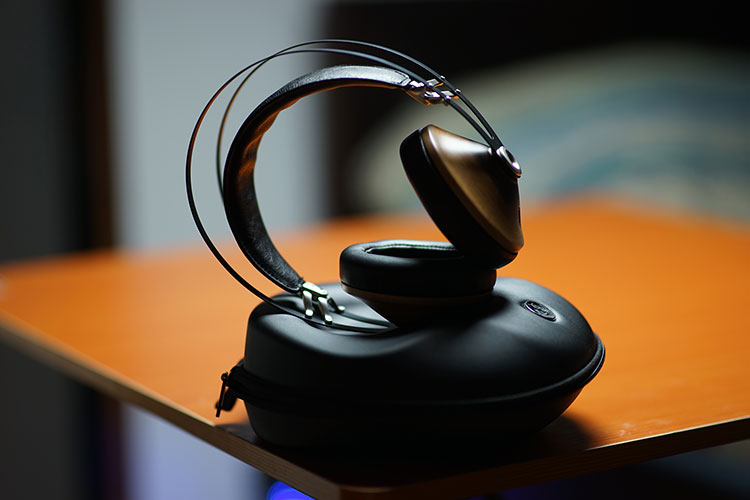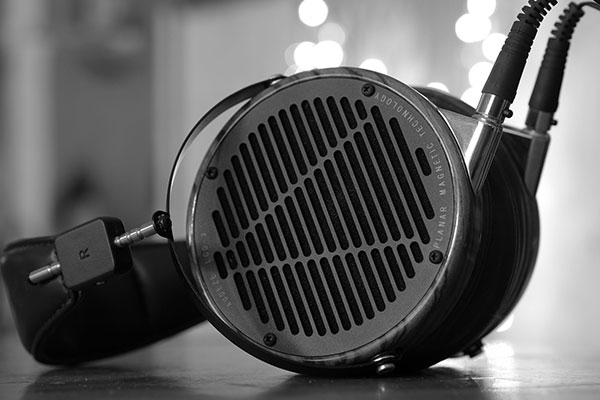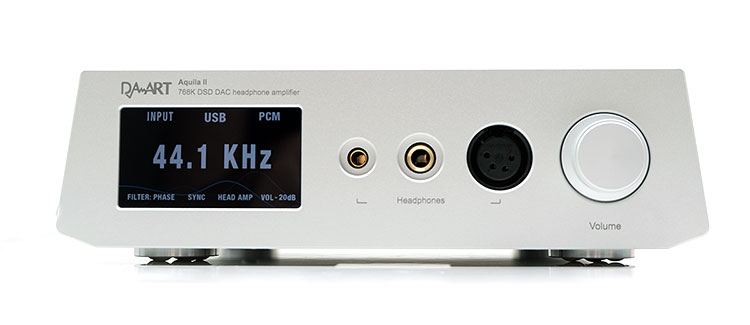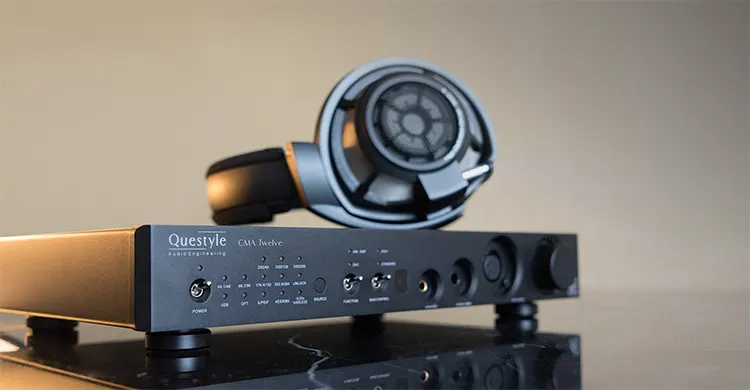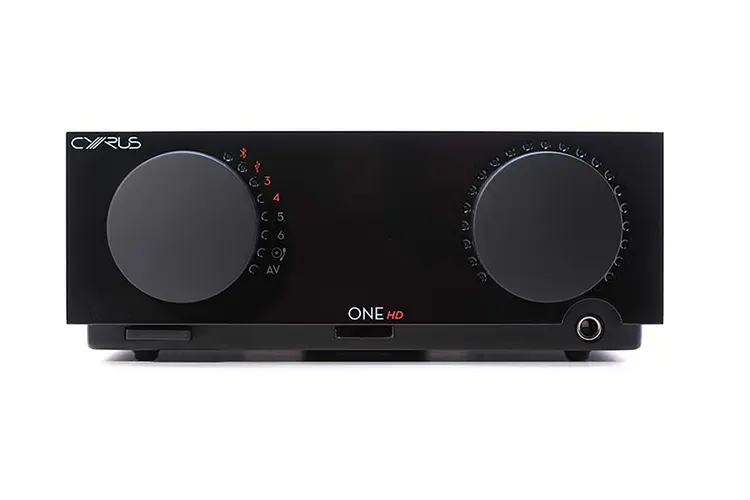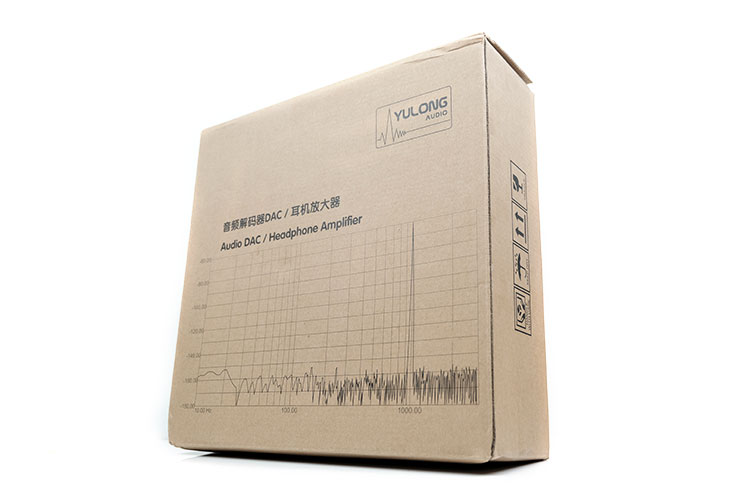Synergy
Efficiency
Sensitive IEMs such as the Ultimate Ears Live (10Ω, 105 dB @1kHz 1Vrms) will not come across with a completely black background due to their impedance, especially with the 4.4mm balanced cable.
Headphones with a higher impedance such as the Audeze LCD-3 (110Ω, sensitivity of 101dB @1kHz 1Vrms), can easily be driven with the Aquila III without noise. The Meze Audio 99 Classics was even easier to drive (32Ω, 103dB @1kHz 1Vrms) than the Audeze, with a black background as well.
As a DAC
When used as a standing DAC, the volume is maxed, the headphone amplifier is disabled and the Aquila III goes through minimal processing.
This is a good use for items such as desktop amplifiers or two-channel systems, which may have an inferior DAC, but a good amplification unit. When hooked to my portable Yamaha office system and the WiiM Pro streamer, the performance easily surpassed the price of the other gear combined.
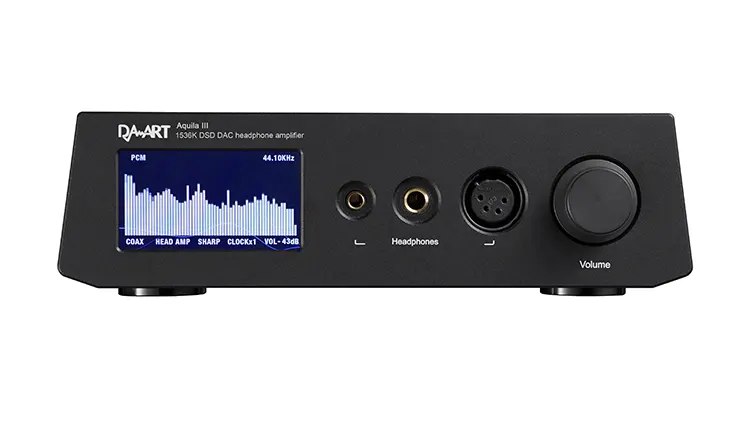
As a Headphone Amplifier
Using the Aquila III DAC and up to 4w of power, the headphone amplifier drove all of my listening sources with ease. I never raised the volume level above -38dB, for fear of too much power.
As a Pre-Amplifier
When using external powered speakers, or a power amplifier; the Pre-Amp mode provided plenty of power. I used the Aquila III to watch movies or shows on my MacBook Pro paired with the Edifier R1280T speakers.
The volume controls on both the Aquila and Edifier could be used to fine-tune the volume. I found myself raising the volume on the speakers first, then filling in any lower-volumed parts of the movies with the Aquila.
Pairings
Meze 99 Classics
The 99 Classics are known for their classically neutral and natural sound, which paired well with the Aquila III.
Coming across with a clean, detailed signature already; the Aquila III added depth to the Meze’s, as well as accuracy in placing instruments and vocals. The soundstage expanded a bit but could be as much about the cable choice as the amplification.
The balanced cable added a somewhat holographic sound to the stellar 99 imaging, which helped across the sound signature as well. Bass depth increased, with better authority and control while the top expanded on the opposite end, showcasing the excellent treble note of the 99 Classics.
Vocals did seem too far forward using Clock-1, but the pairing in Clock-2 mode brought that under better control. I preferred Clock-2 overall with the Meze’s as well.
The “Short” filter minimized decay, leading to a thinning of the sound, while “sharp” added distinct cutoffs without the thinning. My favorite though, was the “Slow” filter, which added depth while adding a certain richness to the 99 Classics, which can sound a bit dry in some circumstances.
Audeze LCD-3
The planar-magnetic driver of the LCD-3 counters the Meze’s dynamic driver with a warmth in the signature I prefer. On average, I had to raise the Aquila III volume 10 notches to match the Meze’s ease of drive.
My preferred clock setting for the LCD-3 was Clock-1, adding an amount of detail and clarity, which can be somewhat lacking in a planar.
The Short filter added a succinctness to the sound, which balanced the warmth of the overall tone nicely, and Sharp added a bit more, for a tighter signature making for a less flat sound, which can also be detrimental to planar’s.
The punchiness of the low end was aided by the Aquila III Slow filter setting, making for a deeper lingering thump to the bass notes, without losing detail. The ability to change filter and Clock settings was more of a positive here than the Meze, which was more set-and-forget.
Ultimate Ears Live
Known as a reference standard for neutrality, the Live lacked a bit down low for my tastes in stock form. Using the Null Audio cable added warmth, which was lacking as well. I also preferred the Aquila III Clock-2 setting, which added more warmth as well.
The Short filter lost a level of thickness to the notes, which was not conducive to my listening preferences. Sharp allowed the notes to truncate without losing detail. Slow added length to the notes without losing detail.
Female vocals shined using Aquila III Clock-1, showing a level of detail, which came across as non-grating or too piercing. There was no added lift to the placing, either. The ease with which the Aquila III could drive IEMs led to turning the volume down as much as -15dB to -20dB compared to the easy-to-drive 99 Classics.
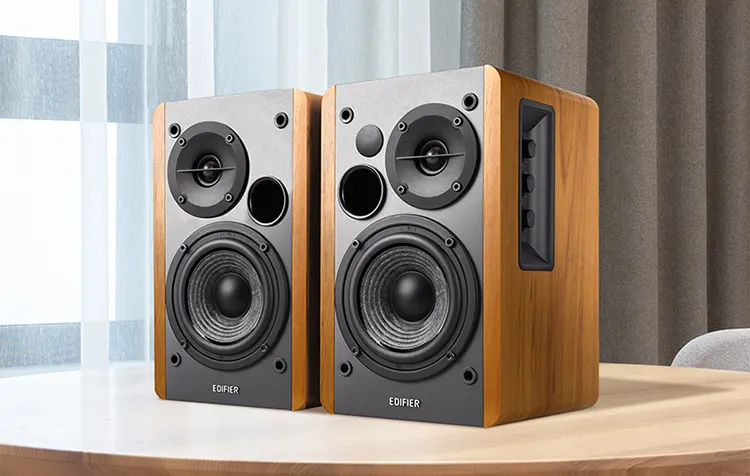
Edifier R1280T
Running the Aquila III in Pre-Amp mode allowed the (limited) power of the Edifiers to be utilized. I was able to comfortably run the Edifier R1280T at full volume, adjusting the Aquila instead. The comfortable listening volume was on par with the Meze’s at -55 dB.
There is only so much an amplifier can do for a budget-oriented $100 bookshelf speaker, but the Aquila made the listening easy. Clock-1 added some missing detail, making lower-volume movies easier to hear instead of raising the volume.
Clock-2 provided a small push-down below, which really was not needed. The Edifier provides quite a good bass sound without help.
As mentioned, the Edifier was used for music and movies, and both Clocks worked equally well. Clock-1 allowed for better discerning of voices in quiet passages, whereas on Clock-2 the volume had to be correspondingly raised on the same passage to ensure the words were heard.
A budget-powered speaker, with good technical aspects, but not great benefitted from the Aquila III regardless of Clock setting.
Select Comparisons
YULONG DA-ART Aquila II
The Aquila II was quite a surprise when reviewed, bestowing 4w of power, and a sound, that came across with a nearly neutral signature.
Utilizing the different filters allowed for a more personalized signature, and was as easy as changing the Sync modes, giving many possible sound customizations. Similar to the Aquila III, a lack of a remote means you have to keep the unit close at hand, but that should not really count against the performance.
Technical
Utilizing a return to their Sabre roots, the Aquila II has an ES9038PRO single DAC chipset implementation combined with an XMOS XU208 USB stage capable of decoding up to PCM 32Bit/768kHz and DSD512.
Without the ability to receive an analog DAC signal, you are “limited” to digital sources, including portable devices such as your Smartphone.
Three filters similar to the Aquila III allow for customizing the signature as well as Sync, which is fully FPGA-based and asynchronous SRC mode, (ASRC) that goes through the ESS internal digital processing to get the more familiar clean Sabre sound.
Phase
This minimizes the pre-ringing effect and the default filter setting; this is equivalent to the minimum phase fast roll-off filter in the main ESS description.
Sharp
This represents a flat response and is recommended for general-purpose use. YULONG describes this filter as being suitable for most genres and is the equivalent of a fast roll-off or linear phase filter in the main ESS description.
Slow
A gentle roll-off on the high frequency. This is recommended for music that benefits from a smoother presentation and is the equivalent of a slow roll-off, linear phase filter in the main ESS description.
Design
The Aquila II carries the isosceles trapezoid form factor on the sides and front plate with the same-sized screen on the left. Similar in weight at 4Kg, you could be forgiven in thinking both units were the same, until you delve into the display.
Instead of a single row of four sub-menus on the bottom of the display, the Aquila II carries three; filter sync and user mode. The lettering is slightly larger as well as the information on the top part of the screen, which shows input method, and decoding.
Performance
Providing up to 4w of power in balanced mode, the Class-AB amplifier can drive headphones such as the Abyss Headphones Diana V2 without fuss. Single-ended power is limited to 1.6w, which is still able to drive efficient headphones such as the Meze 99 Classics or Empyrean without trouble.
Connectivity on the back side carries over into the Aquila III, which is identical to the II. When something is as versatile as the Aquila II connection-wise, why change it?
Questyle CMA12
Questyle is known for staying true to its nature of producing first-class DAPs, which carried over into desktop amplification as well. Their Dongle/DACs, such as the M15 and M12, are among the most highly regarded versions as well.
An upgrade to the venerable CMA 400i, the CMA12 carried an AKM AK4490EQ DAC chip with true DSD inside. The delivery of power came about through a Class-A amplifier as well.
Technical
The AKM AK4490EQ was at the time the latest offering in a DAC chipset and functioned like a flagship should.
With the ability to support up to 384kHz/32Bit PCM and DSD Native DSD256 up to 2W @32Ω (balanced headphone jack), the Questyle delivers plenty of power.
A nice addition to the CMA12 is the inclusion of a “studio” or “standard” switch, which when activated allows for the use of the CMA12 in a studio setting, matching the power of the professional equipment for instant feedback on recordings through the 6.35mm single-ended jack.
Design
Shorter in height, but wider, the CMA12 looks like it could fit right into a home rack system. The front carries headphone ports of 2.5mm balanced, 6.35mm single-end, and XLR balanced options. A bias gain toggle allows for a bit of customizing in your listening as well, something lacking on the Aquila III.
A multitude of options on the back panel allows the Questyle to be hooked in as many combinations as the Aquila III.
This includes a USB Type B Input, SPDIF input and output, optical input, AES/EBU input, balanced XLR x1 pair, and an unbalanced RCA x1 pair (the last two bypass the amplifier, using only the internal DAC). Bluetooth connectivity is added as well.
I found the design to be in keeping with Questyle’s efficient layouts but wished for a larger font on the front. Thankfully a remote is included, which allows for complete control.
Performance
Known for its clean, clear, detailed sound; the CMA12 did not disappoint. To me, the Questyle mantra provides a baseline for what clarity and detail retrieval should be. Without adding coloration to the sound, the music played comes out as recorded.
While not as powerful, (and felt using the LCD-3), the Questyle sounded more detailed than the Aquila III. Note placement was accurate and with the intended weight, presenting one of the cleanest sounding amplifiers I had heard to date.
There is almost no coloration to the sound, and what could be construed that way is actually to me a vibrant, rich energy. That energy promotes itself as coming through with excellent detail and clarity but with more of that vibrancy. Detail promotion permeates through separation and the laying of the sound as well.
Cyrus Audio One HD
The Cyrus Audio One HD is a versatile Class-AB amplifier that can essentially substitute for your home system amplifier and be used as a headphone amp, pre-amp, and hook an MM cartridge turntable up as well. Bluetooth connectivity is also provided for streaming purposes.
Technical
A large toroidal transformer, which powers a Class-AB headphone amplifier provides up to 700mA, while an amplifier of 100w (hybrid Class-D) in two channels with SID (Speaker Impedance Detection) can power a set of speakers.
Asynchronous USB 2.0 input for decoding up to 32/192k, and DSD 128, along with an optical toslink digital input, coaxial SPDIF digital input, an RCA input, and even a built-in MM phono stage
You also get aptX HD compatible Bluetooth compatibility as well as 3-line level inputs, including an AV integration option to round out a very versatile unit.
When using the headphone amplifier, the toroidal transformer powers only the headphone amplifier, providing silent operation; a nice feature.
Design
The front of the narrow, deeper amplifier is dominated by two LARGE knobs. The one on the left controls the source, while the right one controls volume.
While I appreciated the simplicity, the LCD lights on the chosen source were exceptionally bright and to the point that you could not read the front panel.
The right knob controls the volume, and each “click” is not equivalent to an LCD light “step” on the dial. While I appreciate the incremental adjustment ability, not having the LCDs move in an equivalent manner leads you to much turning of the knob. It was not even in a discernible pattern either.
The smaller footprint of the amplifier was appreciated for its space-saving aspect while providing a multitude of connectivity options. The unit did give off a fair bit of heat, so ventilation of your space should be considered.
Two sets of speaker jacks edge the back of the One, while the connecting options are protected. This is good thinking, since you may want quicker access to the speaker connections instead of the source options. Firmware can also be updated via a USB-B port on the back when needed.
Performance
The ONE HD comes across with a clean and clear sound, with enough air between notes to provide a spacious listening environment. Near neutral, without coloring the sound or making the quality antiseptic, or without body, the ONE HD presents an openness to the sound, which is refreshing.
Separation is very good as a result, which can sometimes lead to a thinning quality of sound. Not here. While not holographic, the soundstage fills in wonderfully with precision and accuracy towards placement and harmonics.
What I hear is true, clean, and detailed. Hooking up a less-than-neutral DAP, such as the Shanling M6 Pro or the Cayin N6ii E01 shows the source sound takes precedence. That warm, richness of each source is not culled going through the Cyrus. If the source is rich, the sound emanating from within is rich as well.
I would rate the sound of the Class-AB headphone amplifier on par with the Aquila II, but falling behind the Aquila III in terms of detail retrieval.
Two-channel sound through the Class-D amplifier is quite good, with an amazing amount of power in reserve. Rated at 100w, there is no need to question the number. Through my ProAc Tablette Reference 8 stand speakers, the sound was quite good but not on par with my home system McIntosh MA6100.
Our Verdict
Even with a price increase, the YULONG Aquila III counters the additional money invested over the previous model with superb sound characteristics and a Class-A amplifier. Usability and functionality are straightforward and easy.
The four sub-menus provide clear access to their respective changes, even if the lettering could be bigger. One will find this on their desktop, most likely near your workstation as a result of that smaller lettering and lack of a remote. The different shapes of the unit may even provide a conversation piece as well.
Those detractions do not overshadow the performance, which is competitive in this price range. Two distinct sound signatures are powered by a healthy 4W, which can drive most of the high-impedance headphones on the market today.
Priced to provide an alternative to higher-priced models as well, the Aquila III comes with many connecting options, and the ability to work in three distinct modes (headphone amplifier, DAC, Pre-Amp).
All of these positives outweigh the slight negatives noted, making the Aquila III an easy recommendation for those looking to declutter their home or work area; as well as an easy-to-use unit to boot.
YULONG Aquila III Specifications
- AK4499EX+AK4191 DAC Chips, with dual decoding mode
- Full FPGA digital signal low jitter processing module, YULONG JIC 5th gen, (Jitter and Interfacing Control)
- PCM up to24 bit/384kHz, DSD DoP 64 and DoP128 natively
- Frequency Response Range: 20Hz-30KHz
- THD+N: 0.001% (Headphone Amp, Pre-Amp); DAC: 0.0001%
- Crosstalk: < -120dB
- Multiple Input Ports: USB, AES, Optical, Coax
- Multiple Output Ports: 4-Pin XLR balanced port, 4.4mm bal and 6.35mm se; RCA and XLR Analogue outputs (on back)
- Unbalanced output power: 1000mW @ 32W, 550mW @ 64W; 230mW @ 150W; 120mW @ 300W; 60mW @ 600W
- Balanced output power: 4000mW @32W; 2200mW @ 64W; 1000@ 150W; 480mW @ 300W; 230mW @ 600W
- Output Impedance: <1W (Headphone Amp); < 20W (Pre-Amp)
- Output Voltage DAC: 3V (RCA)
- Output Voltage DAC: 6V (XLR)
- Output Voltage Pre-Amp: 6V (single-ended, RCA)
- Output Voltage Pre-Amp: 12V (single-ended, XLR)
- Analogue Volume Control (99 steps)
- Supports Windows, iOS, Mac, Android, Linux (some drivers may be needed)
- Aluminum Alloy Metal Shell
- Power Consumption: < 30W
- Dimensions: 240x210x60mm (LxDxH)
- Weight: 4Kg


